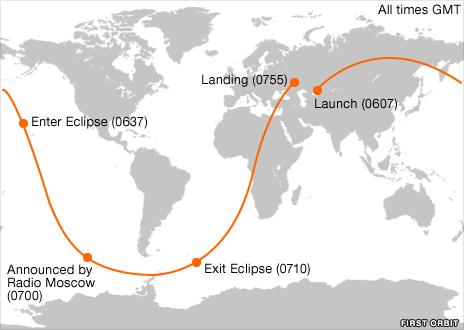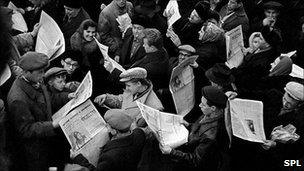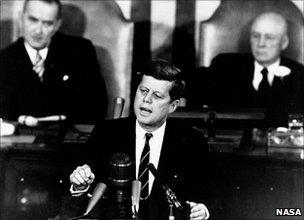Yuri Gagarin: The journey that shook the world
- Published

Gagarin was just 27 when he made his epochal 108-minute orbital flight
Yuri Gagarin's single orbit of Earth 50 years ago this month ushered in the era of human spaceflight.
Gagarin's 108-minute flight was another major propaganda coup for the Soviet Union, which had successfully launched the first satellite - Sputnik - in 1957.
"I was a young fighter pilot in Germany I was flying F-102s in Rammstein Germany. We were more focused on the building of the Berlin Wall that year, rather than the space race," says Nasa astronaut Charles Duke, who walked on the Moon during the Apollo 16 mission in 1972.
"When he flew, my first impression was - well, they beat us again."
Sergei Khrushchev, the son of Nikita Khrushchev, who was the Soviet premier at the time of Gagarin's flight, told BBC News: "We were very proud but we did not really understand how important it was. It was one more flight, one more achievement."
But he says his father was acutely aware of the significance, and orchestrated a celebration in Red Square upon Gagarin's return to Moscow.
"When we look at the response of the Muscovites, where everyone was in the streets, on the roofs of buildings and in the windows, I would compare this celebration with the May 9 victory day (the end of World War II for the Soviet Union)," says Sergei.
During the Cold War, such "firsts" were used by the USSR to claim technological might and ideological superiority.
But the architects of both the US and Soviet space programmes had loftier ambitions of sending humans on voyages around the Solar System.
The Americans and the Soviets experimented by sending animals into space prior to launching people.
Despite several notable failures, the successful tests signalled that humans were capable of surviving the stresses of spaceflight.

The launch on 12 April 1961 took place from what is now Baikonur Cosmodrome in Kazakhstan
Yuri Gagarin was one of 20 prospective cosmonauts selected for the Soviet space programme in 1960. The candidates were put through a gruelling training regime, including long stays in isolation chambers.
Cathleen Lewis, curator of international space programmes at the National Air and Space Museum in Washington DC, says: "They were performing enormous feats of physical training... They wanted to test the limits of their pilots."
The list of 20 candidates was eventually whittled down to two: Gagarin and fellow test pilot Gherman Titov.
It has been suggested that Gagarin's humble upbringing may have tipped the scales in his favour. While Titov came from a middle-class background, Gagarin was the son of workers. The Soviet leadership may have regarded this as a demonstration that, under communism, even those who came from modest families could succeed.
But others insist that the cosmonauts' performance during the selection process was much the more important factor.
In early 1961, US astronaut Alan Shepard had been training for a sub-orbital flight on a Mercury-Redstone rocket scheduled for May that year.
The Soviets were not aware of the schedule, but Sergei Korolev, chief scientist for the USSR's space programme, was worried the US would be first and pushed for a manned launch as soon as possible.
'Here we go'
On the morning of 12 April 1961, the 27-year-old Gagarin was waiting to be launched into space atop a 30m-high booster at the Tyuratam test range in Kazakhstan (now the Baikonur Cosmodrome).
As the rocket blasted off at 0907 local time, Gagarin reportedly said "Poyekhali", or "here we go".

Gagarin went into darkness behind the Earth over the Pacific. He saw the Sun rise as he was moving over the South Atlantic
Standing 5ft 2ins tall, Gagarin was better suited than some for the cramped conditions of his space capsule.
He was able to consume food through squeeze tubes and kept mission control updated on his condition using a high-frequency radio and a telegraph key.

The first manned spaceflight caused a sensation in Moscow as it did elsewhere
According to a transcript of the communication with ground control, Gagarin was struck by the view through the capsule's window, commenting on our planet's "beautiful aura" and the striking shadows cast by clouds on the Earth's surface.
But the cosmonaut had no control over his spacecraft during the historic flight.
"No-one knew what effect zero-g would have on the astronauts when they were up there. They were so concerned that he might be disorientated and disabled once he was in weightlessness," says Reginald Turnill, the BBC's aerospace correspondent from 1958-1975.
"It was decided right from the beginning that he would not be allowed to control the spacecraft, it would all be done from the ground."
Breaking free
But there was also concern about what would happen if control from the ground was lost. So Gagarin was given a sealed envelope containing codes that would allow him to assume control of the spacecraft with the help of a crude onboard computer.
Yuri Gagarin: "I was never nervous during the space flight - there were no grounds for it"
It was only much later that it became known just how close the mission had come to disaster.
Cables linking the spacecraft's capsule to the service module failed to separate before Gagarin's return to Earth. So Gagarin's capsule was unexpectedly burdened with an extra module as it re-entered the Earth's atmosphere.

The cosmonaut baled out of his capsule before it hit the ground
Temperatures in the capsule became dangerously high and Gagarin was spun around wildly, almost losing consciousness.
"I was in a cloud of fire rushing toward Earth," the cosmonaut later recalled. It was 10 minutes before the cables finally burned through and the descent module, containing its human passenger, tore free.
Gagarin baled out before his capsule hit the ground, parachuting to a safe landing near the Volga River.
On his return, the previously unknown test pilot was transformed into a worldwide celebrity. Monuments were erected to honour his achievement, streets were named after him in many Soviet cities. Gzhatsk, the town where he spent much of his childhood, was even renamed Gagarin.
Nikita Khrushchev hugged the cosmonaut as he stepped off the plane on his return to Moscow. Khrushchev would subsequently compare Gagarin to Christopher Columbus and bestow upon him the status of Hero of the Soviet Union.
Along with other Western space correspondents, Reg Turnill was despatched to Moscow to cover a post-flight press conference.

US President John F Kennedy upped the ante following the USSR's successes in space
"The whole purpose was to score points off the West," he recalls, adding: "We were given the ultimate idiot's treatment."
When asked whether he had landed in the capsule or had ejected and finished his journey by parachute, Gagarin replied: "The landing proceeded successfully and my presence here demonstrates the success of the systems."
The first human spaceflight intensified the incipient space race between the superpowers.
About a week after Gagarin's flight, US President John F Kennedy tasked his Vice-President Lyndon Johnson to report back on the state of the US space programme, external.
Johnson warned that urgent action was needed to prevent the Soviet Union leaving the US far behind in space exploration. But with sufficient resources and effort poured into its space programme, the US could be first to send a man to the Moon by the late 1960s, external.
The rest, as they say, is history.
Paul.Rincon-INTERNET@bbc.co.uk